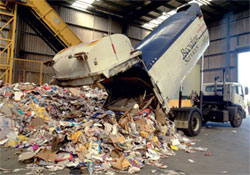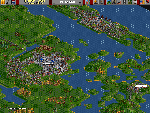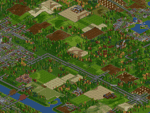.Lots.of.
 This nice picture at the left is a perfect synonym for what you can expect here. The truck unloads tons of waste paper.
This nice picture at the left is a perfect synonym for what you can expect here. The truck unloads tons of waste paper.
No, I will not cover your mind with waste, don't fear. I also do not want to state, that the presented files below are not much more worth than garbage. It really depends on you, what you're going to make out of it.
Anyway, the stuff below are my two cents I sacrifice to make the www more useful. And the good things is: unless the bandwith consuming offers from those pseudo free of carge sites, I honestly give you everything below as f r e e ware. Bear in mind, that freeware does not mean that you could debug, analyse, change and redestribute the code. Just take it as it is and use the software as intended.
Of course, the trade off is quite simple: I will not provide any support, even if you crawl down on your knees and pray for it. If you're still unsure wheter to take a try, please consult the disclaimer for further information.
.File.format.
Most of the files were produced during my studies. You will find source codes, documentations, hints, presentations and something like that. Downloadables are all compressed with WinZip. The raw file format will be mentioned anyway.
Quark has nothing to do with the German word for 'curd', nor with some nuclear physic's particles. Quark is the result of a project at university in programming a Java RMI application for the course "UE Softwareengineering WS98/99 (Wender)".
 Quark itself is a network based client - server gaming application, following the famous and successfull first person shooter of id software. Well, due to performance reasons and the lack of Java's 3D abbility (at the implementation time, years ago:-), Quark uses a two dimensional bird's eye view. It was not the intention to replicate id software's C based 3D engine in Java, but to demonstrate the Java RMI API for developing a client - server driven application. The server application was done by myself, whereas the client was implemented by Jürgen Wolf.
Quark itself is a network based client - server gaming application, following the famous and successfull first person shooter of id software. Well, due to performance reasons and the lack of Java's 3D abbility (at the implementation time, years ago:-), Quark uses a two dimensional bird's eye view. It was not the intention to replicate id software's C based 3D engine in Java, but to demonstrate the Java RMI API for developing a client - server driven application. The server application was done by myself, whereas the client was implemented by Jürgen Wolf.
.system.requirements.
Well, like any Java application too, Quark needs the java runtime environment installed yet on your PC. Quark was developed, using JDK version 1.1.8. For performance reasons, we recommend a Pentium class PC for windows operating systems. Linux should be satisfied with a i486 compatible PC. It depends on the amount of simultaniously logged in clients, their systems' speed and the network performance. Remember, performance is a unit you never can get enough of! For technical reasons, the server is restricted to serve 10 clients at the same time.
.Installation.
- Download the .JAR files.
- Unpack them.
- Verify, that
CLASSPATH is set correctly.
- Start
rmiregistry.
- Start Server (
java UIQuarkServer).
- Start Client(s).
If you encounter any problems, like stub procedure errors and required recompile, refer to the included documentation.
.Labyrinth.generation.
For playing Quark, you will need to generate a world - which is in fact a kind of crazy maze. The released version of Quark already consists of a demo world - it needs to be downloaded seperately, but it's much more fun to generate your own ones.
Now, you can do that manualy, which is very easy, as long as the world size is fixed and the files are ASCII textfiles. But it's much simplier to use the labyrinth generator, a simple DOS tool, working in the famous 13h graphic mode (yeah, you know the mode - you are a coding maniac, I like you :-). Use your mouse to generate a sum of labyrinths for your satisfaction...
By the way, much thanks to Thomas Hauk, who inspired me in programming Turbo Pascal (you know TP and the mystic Turbo Vision - then you *must* be a coding maniac :-) in the early 90s.
.Files.
And finally here are all the files to download:
 Quark Client | quarkclient.jar | JAR 61KB | Java executeable
Quark Client | quarkclient.jar | JAR 61KB | Java executeable
 Quark Server | quarkserver.jar | JAR 43KB | Java executeable
Quark Server | quarkserver.jar | JAR 43KB | Java executeable
 Labyrinth generator | lab.zip | ZIP 8KB | DOS executeable
Labyrinth generator | lab.zip | ZIP 8KB | DOS executeable
 Quark standard maze | test.zip | ZIP 3KB | QUK, Quark maze file
Quark standard maze | test.zip | ZIP 3KB | QUK, Quark maze file
Transport Tycoon Deluxe (TTDLX) is a great, fantastic simulation game. It catches your fancy imediately, not letting you out for hours! Even if it was coded in the middle of the 90s, there are still many guys playing it, probably because of the minimum hardware requirements (yeah, a lot of tuned assembler code). Take a look at the developer's page of Chris Sawyer or read the offical semi FAQ page for further information on the game itself.
If you do not own a legal copy of TTDLX, you may use OpenTTD instead which is more than a good replacement. It also supports additional features.
.Map.Descriptions.
The following section gives a short description of each scenario map and its features. All the presented maps have been generated with the German version of Transport Tycoon Deluxe, anyway they should run with other language version too.
Click on the images nearby, to receive a large view or go directly to the file section to download the offered scenarios. Simply decompress and copy them in your designated save games directory. Start TTDLX and choose playing a scenario. Select and play it!
.Map.1.
 The first map is constructed for start date 1950 and is situated in temperate landscape. It has a medium amount of land mass, a dedicated highland and mountain area in the West, while you'll find a wet region in the East; many big cities are connected through a nice highway network. The names are more or less mere coincidence. There has not been generated too much wood yet, so you may decide by yourself about the percentage, because it's very inefficient to remove the wood afterwards.
The first map is constructed for start date 1950 and is situated in temperate landscape. It has a medium amount of land mass, a dedicated highland and mountain area in the West, while you'll find a wet region in the East; many big cities are connected through a nice highway network. The names are more or less mere coincidence. There has not been generated too much wood yet, so you may decide by yourself about the percentage, because it's very inefficient to remove the wood afterwards.
.Map.2.
 The second scenario is again constructed in temperate landscape, starting date is 1950. The relation between land mass and water is balanced at a level of about 70:30. Mountains appear at the same percentage than flat landmass will. I tried to create as much industry as it seemt possible and realistic. You will find many big cities (over 2000 inhabitants) and spread industries to be served by your company. There already exists a sophisticated highway system, connecting the main towns in a big square like route. Again, the city names are pure phantasy, don't mind anyway. The higly complex landscape is reflected in the file size, of course.
The second scenario is again constructed in temperate landscape, starting date is 1950. The relation between land mass and water is balanced at a level of about 70:30. Mountains appear at the same percentage than flat landmass will. I tried to create as much industry as it seemt possible and realistic. You will find many big cities (over 2000 inhabitants) and spread industries to be served by your company. There already exists a sophisticated highway system, connecting the main towns in a big square like route. Again, the city names are pure phantasy, don't mind anyway. The higly complex landscape is reflected in the file size, of course.
 TTDLX map 1 | trt00.zip | ZIP 80KB | Transport Tycoon map
TTDLX map 1 | trt00.zip | ZIP 80KB | Transport Tycoon map
 TTDLX map 2 | trt01.zip | ZIP 144KB | Transport Tycoon map
TTDLX map 2 | trt01.zip | ZIP 144KB | Transport Tycoon map
 Quark itself is a network based client - server gaming application, following the famous and successfull first person shooter of id software. Well, due to performance reasons and the lack of Java's 3D abbility (at the implementation time, years ago:-), Quark uses a two dimensional bird's eye view. It was not the intention to replicate id software's C based 3D engine in Java, but to demonstrate the Java RMI API for developing a client - server driven application. The server application was done by myself, whereas the client was implemented by Jürgen Wolf.
Quark itself is a network based client - server gaming application, following the famous and successfull first person shooter of id software. Well, due to performance reasons and the lack of Java's 3D abbility (at the implementation time, years ago:-), Quark uses a two dimensional bird's eye view. It was not the intention to replicate id software's C based 3D engine in Java, but to demonstrate the Java RMI API for developing a client - server driven application. The server application was done by myself, whereas the client was implemented by Jürgen Wolf.Quark Client | quarkclient.jar | JAR 61KB | Java executeable
Quark Server | quarkserver.jar | JAR 43KB | Java executeable
Labyrinth generator | lab.zip | ZIP 8KB | DOS executeable
Quark standard maze | test.zip | ZIP 3KB | QUK, Quark maze file
 This nice picture at the left is a perfect synonym for what you can expect here. The truck unloads tons of waste paper.
This nice picture at the left is a perfect synonym for what you can expect here. The truck unloads tons of waste paper.
